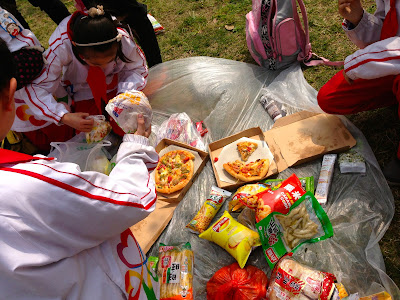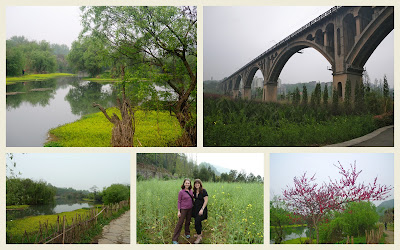Lizzy and I with the cops. Don't buy their tough guy looks. They were smiling and playing with the children all day.
This video is an overview of our day featuring photos and footage. It begins with the students getting ready to board the buses, Lizzy entertaining them with a quick lesson on how to do the "Hand Jive" and pictures from the temple and picnic. For something different, I put it to music and chose Eddie Vedder's cover of "Hard Sun" from the Into the Wild soundtrack because it was in my head all day. Enjoy.
It took over 30 buses pre-arranged through a travel company to transport us from school to Kongxuetang, a Confucian Temple. We waited on the grounds for everyone to arrive while Mrs. Chen, one of the headmistresses, gave a speech that I’m guessing was about the temple and behavior expectations. Once all of the classes had ascended up the stairs, the students, under the direction of their class leader, queued up and we moved, one class at a time, swiftly through the temple.
Confucius (551BC – 479BC) was an educator and philosopher who valued personal relationships, morality, sincerity and justice. His most notable teaching is still taught in education systems and religions worldwide:
The Golden Rule: What you do not wish for yourself, do not do to others.
Humanism is the basis of Confucianism. Five main virtues are practiced:
Rén (Humaneness)
Yì (Justice)
Lĭ (Propriety)
Zhì (Knowledge)
Xìn (Integrity)
It is a blessing in disguise that Lizzy and I cannot read Chinese because we would’ve wanted to spend the entire day reading every character on the premises. Instead, we were whisked away to a picnic.
The picnic was on the bank of a river at a wetland park, gorgeous scenery and a large enough space to accommodate 1000 students! The school packed our lunches and the students brought their own.
The students took picnicking to a whole new level. We watched as the kids sat in groups of 8-10 and dumped everything they brought out of their backpacks and into the center of the circle. We’d never seen so much food! We were impressed and naturally wanted to take photos to share with folks back home for picnic inspiration.
Pizza?!
As we walked around, students walked up to me and gave me Hershey’s Kisses (score!) and some pieces of candy. I must have been moving too quickly, snapping photos. I turned around and noticed Lizzy with her hands full of food!
Once I stopped to take pictures of Lizzy, the students lined up to give us more food. It was unbelievable. Apparently, students share food with the teachers they like. I was happy to notice that the principal and headmistresses all had sizeable food piles as well! I have never experienced generosity and kindness at this level. Between the two of us, we had 5 bags of food. Fortunately, we share an office with 3 teachers so we’ll bring most of it back to share and bring some with us next weekend when we visit Xijang Miao Village and Jianhe Hot Springs
Lizzy and I found a spot to sit and enjoy our lunches, but the food parade continued. Students brought us three different types of noodles, mango sushi (my favorite), a chicken paw, homemade bread, and fruit salad (with dragon fruit and lychee) to name a few notable items.
Lizzy and I found a spot to sit and enjoy our lunches, but the food parade continued. Students brought us three different types of noodles, mango sushi (my favorite), a chicken paw, homemade bread, and fruit salad (with dragon fruit and lychee) to name a few notable items.
Exhausted after all the excitement of learning more about Chinese history and being a part of the largest picnic either of us had ever attended, you can imagine our frustration when we found ourselves stranded on the side of the road. Of the 30+ buses, ours was the one that broke down. Thankfully, our time waiting to be rescued was brief and another bus showed up with delightful Hello Kitty upholstery and we were on our way, again.
Guiyang No. 4 Experimental Primary School takes two field trips a year; one in spring and one in fall. For those of you coming to Guiyang next fall, I sure hope your time here coincides with the fall trip.
Field Trip Tips:
- Dress in layers and wear comfortable shoes
- Always carry a small umbrella
- Bring a reusable grocery bag for the gifts of food the students will give you
- Don't forget your camera!
Natalie















































